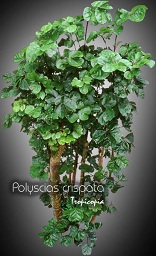Table of contents
Chicken gizard aralia

Latin Name: Polyscias crispata
Category: Aralia
Family: Araliaceae
Origin: Malaysia
Climate: Tropical
Growing Zones: 11-10
Care Instructions
The Chicken gizard aralia (Polyscias crispata) is a tropical plant that originates from Malaysia. This aralia plant belongs to the Araliaceae family and is well-suited for growing in USDA zones 11-10.
Complete Care Guide for Chicken Gizzard Aralia (Polyscias crispata)
Watering Requirements
The Chicken Gizzard Aralia, or Polyscias crispata, thrives in a well-balanced watering routine. It is essential to keep the soil consistently moist but not soggy. Water the plant when the top inch of the soil feels dry to the touch. During the growing season, typically spring and summer, the plant may require more frequent watering, approximately once a week. In the fall and winter months, reduce watering to every two weeks, allowing the soil to dry out slightly between waterings. Overwatering can lead to root rot, so ensure that the pot has adequate drainage and avoid letting the plant sit in standing water.
Light Conditions
The Chicken Gizzard Aralia prefers bright, indirect light for optimal growth. While it can tolerate lower light conditions, insufficient light may result in leggy growth and a loss of vibrant foliage. Ideally, place the plant near a window that receives filtered sunlight or in a well-lit room. Avoid direct sunlight, as it can scorch the leaves and cause damage. If you notice the leaves turning yellow or dropping, it may be a sign that the plant is receiving too much direct light. Conversely, if the plant appears to be stretching towards the light source, it may need to be moved to a brighter location.
Soil Preferences
The Chicken Gizzard Aralia thrives in a well-draining potting mix that retains some moisture without becoming waterlogged. A blend of peat moss, perlite, and pine bark works well to provide the necessary aeration and drainage. Aim for a slightly acidic to neutral pH level, ideally between 6.0 and 7.0. Fertilization is important during the growing season; use a balanced, water-soluble fertilizer every four to six weeks to promote healthy growth. In the fall and winter, reduce fertilization as the plant enters a dormant phase. Always ensure that the pot has drainage holes to prevent excess moisture accumulation.
Pests and Diseases
The Chicken Gizzard Aralia is generally resilient but can be susceptible to common houseplant pests such as spider mites, aphids, and mealybugs. Regularly inspect the leaves for signs of infestation, such as webbing, sticky residue, or visible bugs. If you notice any pests, treat the plant with insecticidal soap or neem oil, ensuring to cover both the tops and undersides of the leaves. Additionally, watch for signs of fungal diseases, which can occur if the plant is overwatered or in overly humid conditions. Yellowing leaves and a musty smell may indicate root rot. If this occurs, reduce watering and consider repotting the plant in fresh soil.
Special Care Tips
To maintain the health and beauty of your Chicken Gizzard Aralia, consider the following special care tips: First, regularly dust the leaves with a damp cloth to keep them clean and allow for optimal photosynthesis. This also helps prevent pest infestations. Second, rotate the plant every few weeks to ensure even growth and exposure to light. Third, if you notice the plant becoming too tall or leggy, consider pruning it back to encourage bushier growth. Lastly, during the growing season, you can occasionally mist the leaves to increase humidity, which is beneficial for the plant’s overall health, especially in dry indoor environments. By following these care tips, you can enjoy a thriving Chicken Gizzard Aralia that adds a unique touch to your indoor garden.








